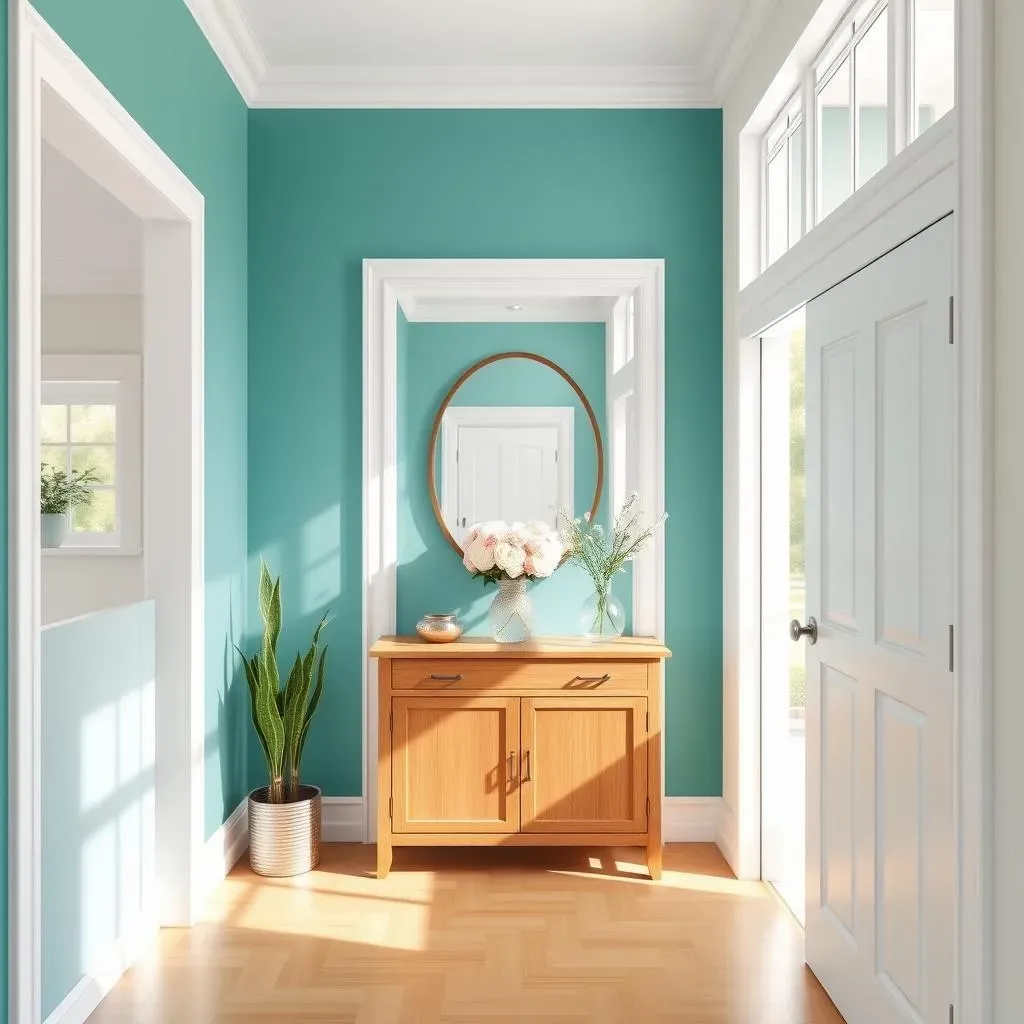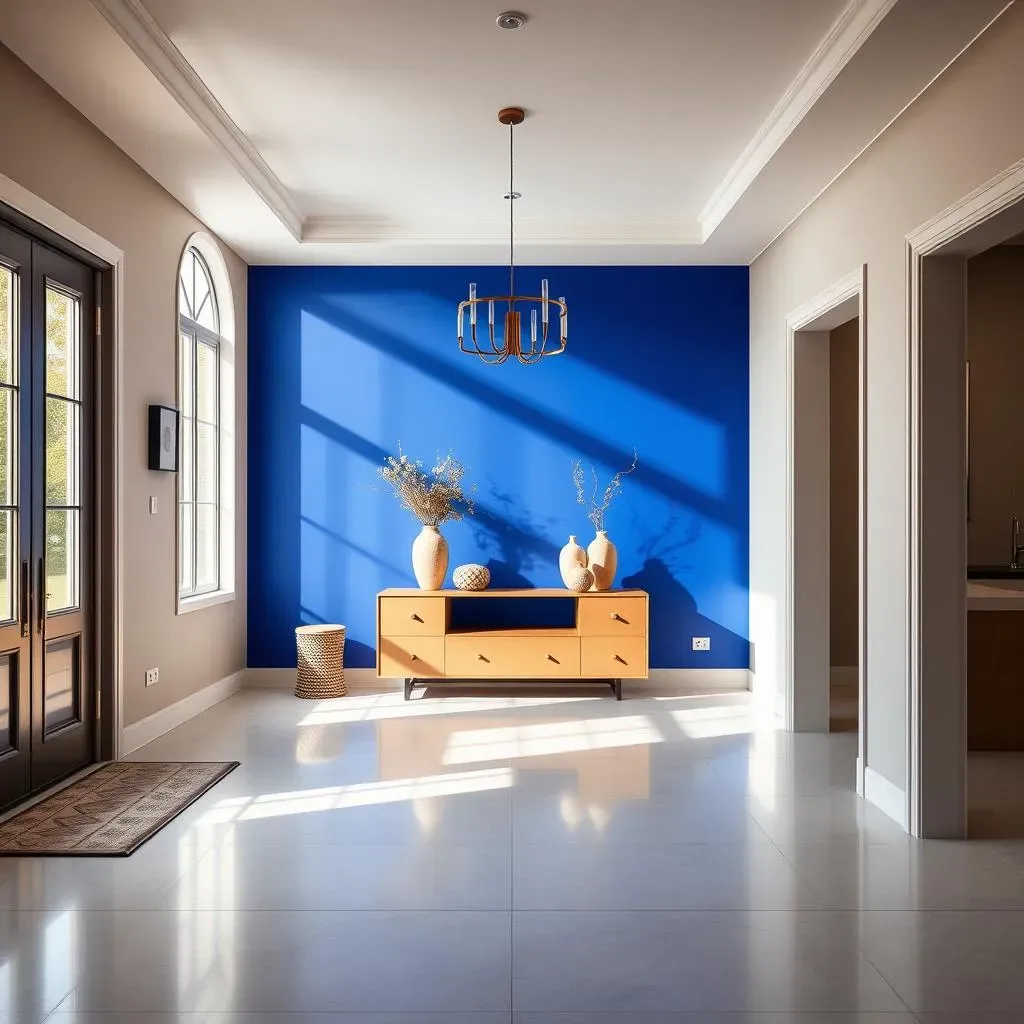Table of Contents
Want to make a killer first impression? Your entryway is the first thing guests see, so let's make it amazing! This article is your guide to unlocking the potential of your entryway with stunning accent wall paint ideas. We'll explore how to choose the perfect color to set the right mood, from warm and inviting neutrals to bold and dramatic hues. Then, get ready to dive into a world of creative accent wall techniques and styles—we’ll cover everything from classic to contemporary, ensuring there's inspiration for every taste. Finally, we'll show you how to tie it all together with complementary décor, creating a cohesive and stylish entryway that's both welcoming and uniquely you. Get ready to transform your entryway from drab to fab with our expert tips and inspiring accent wall paint ideas for entryways! Let's get started!
Choosing the Perfect Accent Wall Color for Your Entryway

Choosing the Perfect Accent Wall Color for Your Entryway
Picking the right accent wall color for your entryway is like choosing the perfect outfit for a first date – it needs to make a great impression! Think about the overall style of your home. Do you have a modern, farmhouse, or perhaps a more eclectic vibe? A bold color like a deep teal or burnt orange might be perfect for a dramatic entryway, while a softer shade of gray or beige might work better in a more traditional setting. Check out our guide to neutral accent wall colors for some inspiration!
Consider the lighting in your entryway. Natural light can completely change how a color looks throughout the day. A color that looks amazing in the morning sun might appear completely different at night under artificial light. Test your paint samples at different times of the day to see how the color changes. You might also want to explore accent wall colors that go with white if you're aiming for a bright and airy feel.
Color Family | Mood | Entryway Style |
|---|---|---|
Warm Neutrals (beige, cream) | Inviting, cozy | Traditional, farmhouse |
Cool Neutrals (gray, blue-gray) | Calm, sophisticated | Modern, contemporary |
Bold Hues (teal, emerald, mustard) | Dramatic, energetic | Eclectic, bohemian |
Don't forget about the surrounding rooms! Your entryway should flow seamlessly into the rest of your home. Choose a color that complements the adjacent rooms, avoiding jarring color clashes. For example, if your living room has warm tones, you might want to stick with a warm-toned accent wall in your entryway as well. If you're looking for ideas for your living room accent wall, check out our article on accent wall paint colors for living rooms.
Finally, don't be afraid to experiment! Order paint samples and test them on your wall before committing to a whole gallon. This lets you see exactly how the color looks in your entryway's unique lighting. You can even try different sheens to see which one you like best. A glossy sheen can add a touch of glamour, while a matte sheen provides a more subtle look. For more ideas on different paint finishes, browse our article on accent wall paint finish ideas.
- Consider your home's style
- Test paint samples in various lighting conditions
- Coordinate with adjacent rooms
- Experiment with different sheens
Accent Wall Paint Ideas for Entryways: Styles and Techniques
The Classic Approach: A Single Bold Color
Sometimes, simplicity reigns supreme. A single, bold color can make a powerful statement in your entryway. Think deep jewel tones like emerald green or sapphire blue for a luxurious feel, or a vibrant sunny yellow for an energetic pop. The key is choosing a shade that complements your existing décor and sets the tone for the rest of your home. Consider the size of your entryway; darker colors can make small spaces feel cozier, while lighter shades can open up a cramped area. For more ideas on bold colors, check out our guide to bold accent wall paint colors.
Remember to test your chosen color in different lighting conditions to ensure you love how it looks throughout the day. Natural light can significantly impact the final appearance, so a sample is your best friend! And don't forget the sheen – a high-gloss finish can add a touch of elegance, while a matte finish offers a more understated look. For more information on choosing the right finish, see our article on accent wall paint finish ideas.
Adding Depth and Dimension: Two-Tone Techniques
For a more sophisticated look, consider a two-tone approach. This could involve painting the upper half of your accent wall a lighter shade and the lower half a darker one, creating a visually striking effect. Or, try using two complementary colors to add depth and dimension. A classic combination is a soft neutral on the top and a bolder hue on the bottom. Remember to use painter's tape for crisp lines, or embrace a slightly more rustic, less-perfect look for a bohemian vibe. If you're into this idea, you might love our collection of two-tone accent wall paint ideas.
- Choose colors that complement each other.
- Use painter's tape for clean lines (or not!).
- Consider the height of your walls.
Another popular two-tone technique is to use a darker shade on a chair rail or wainscoting to ground the space and add visual interest. This is particularly effective in entryways with high ceilings, creating a more balanced feel. You can explore more ideas in our article about accent wall paint colors for dining rooms, which often feature similar design elements.
Beyond Solid Color: Patterns and Textures
Ready to step outside the box? Don't limit yourself to just solid colors! Consider adding patterns or textures to your accent wall to create a truly unique space. Geometric patterns are a modern and stylish choice, and can be achieved using painter's tape or stencils. For a more organic feel, try a textured paint that adds depth and visual interest. This can range from subtle to dramatic, depending on your preference. Explore our ideas on accent wall paint ideas with geometric patterns to spark your creativity.
Alternatively, you could use wallpaper to add a unique pattern or texture to your accent wall. This can be a great way to introduce a bold design element without committing to painting the entire wall. Remember to choose a wallpaper that complements your overall entryway style and doesn't clash with your existing décor. A textured wallpaper can also add warmth and visual interest, especially in a smaller entryway. If you're a fan of textured walls, check out our selection of textured accent wall paint ideas.
Technique | Style | Effect |
|---|---|---|
Geometric patterns | Modern, contemporary | Clean lines, bold statement |
Textured paint | Rustic, bohemian | Depth, visual interest |
Wallpaper | Eclectic, traditional | Unique patterns, textures |
Creating a Cohesive Look: Entryway Accent Walls and Decor
Choosing the Right Decor Style
Once you've got your stunning accent wall in place, it's time to think about the overall look and feel of your entryway. The décor you choose should complement your accent wall color and style, creating a cohesive and inviting space. For example, if you've opted for a bold, jewel-toned accent wall, you might want to balance it with some neutral-toned furniture and accessories to prevent the space from feeling too overwhelming. Consider the style of your home; a modern entryway might pair well with sleek, minimalist furniture, while a more traditional space might benefit from antique or vintage pieces.
Think about the size and shape of your entryway. In a small entryway, you want to avoid overcrowding the space with too much furniture or décor. Choose a few key pieces that make a statement without overwhelming the area. A large entryway, on the other hand, offers more flexibility. You can incorporate a larger console table, a statement mirror, or even a small seating area. No matter the size, think about flow and function; ensure there's enough space for guests to move around comfortably.
- Consider the overall style of your home.
- Choose furniture and accessories that complement your accent wall.
- Think about the size and shape of your entryway.
Accessorizing Your Entryway
Accessorizing your entryway is where you can really let your personality shine! Think about adding artwork, mirrors, shelves, or other decorative elements that reflect your taste and style. Artwork can add a personal touch to your entryway, while mirrors can help to create the illusion of more space. Shelves can be used to display decorative items or to provide a practical storage solution for keys, mail, and other essentials. If you are looking for ideas to decorate your entryway with wall decor, check out our article on accent wall paint ideas for entryways.
Lighting is another crucial element to consider. A well-lit entryway is both welcoming and functional. You might want to add a statement chandelier, sconces, or a stylish floor lamp to create an inviting ambiance. The lighting you choose should complement your overall entryway style and accent wall color. Remember, lighting can significantly impact how your accent wall color appears, so choose carefully! For more ideas on entryway lighting, you might find some inspiration in our ideas for accent wall paint colors for living rooms, as both spaces often share similar design considerations.
Accessory | Effect | Style |
|---|---|---|
Artwork | Adds personality | Various |
Mirrors | Creates illusion of space | Modern, traditional |
Shelves | Provides storage | Rustic, contemporary |
Creating a Seamless Flow
Finally, ensure your entryway flows seamlessly into the rest of your home. Choose décor and accessories that complement the style and color scheme of the adjacent rooms. This creates a cohesive look and feel throughout your house. For example, if your living room has a neutral color palette, you might want to stick with neutral-toned décor in your entryway as well. If your living room features bold colors, you can use those same colors in your entryway, but perhaps in a more subtle way. This creates a consistent theme throughout your home without being monotonous.
Consider using similar materials or textures in your entryway and adjacent rooms to create a sense of continuity. For instance, if you have hardwood floors in your living room, you might want to use a hardwood console table or a rug with a similar texture in your entryway. This creates a visual connection between the spaces and makes your home feel more unified. For more ideas on how to create a cohesive look throughout your home, consider browsing our collection of accent wall colors that go with white, a versatile choice that often blends nicely with different styles.
- Use similar materials and textures.
- Choose a color palette that complements adjacent rooms.
- Consider the overall flow of your home.
